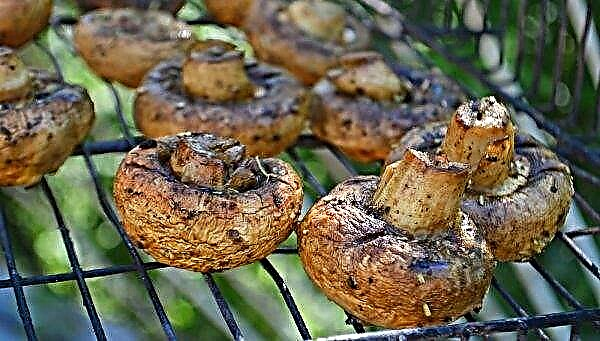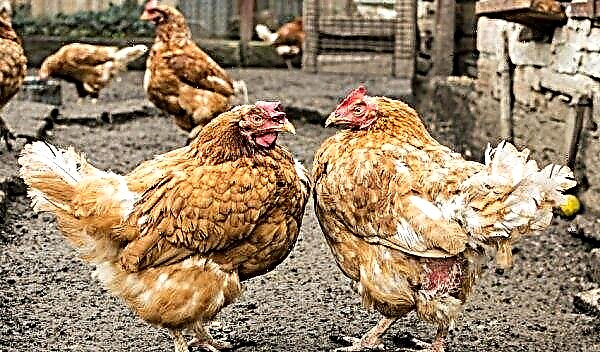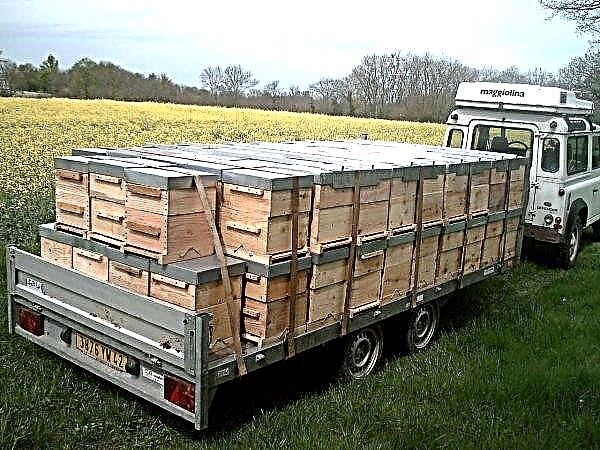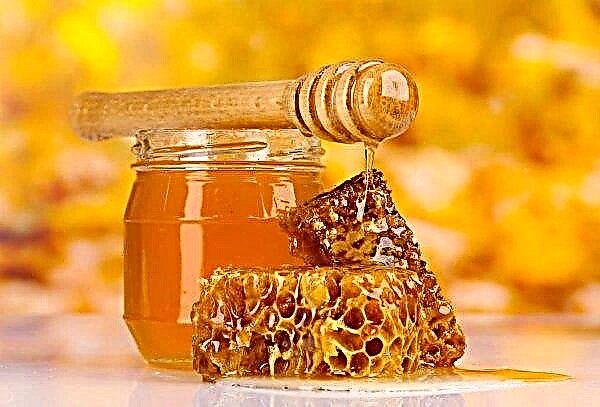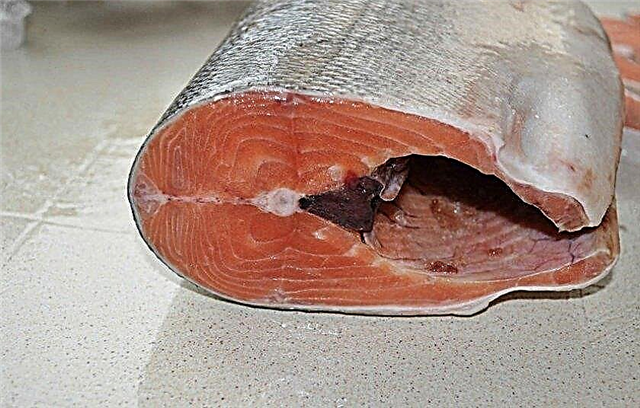In beekeeping, several types of hives are used. The choice of one of them for an apiary often depends on the preferences of the beekeeper or the characteristics of his bee families. In this review, we will focus on one of the oldest types - the hive-lounger.
Beehive lounger: design features and advantages
Beehive lounger is an integral structure, similar to a chest. It is quite simple to use and maintain. Both novice beekeepers and people with experience use it.
Design Features:
- deaf lower part;
- folding lid;
- two sections for keeping 2 bee colonies;
- 2 sets of upper and lower tap holes in the case.
- Advantages of the hive lounger:
- vertically mounted frames are very easy to move with a simple shift to the side;
- convenience for the beekeeper in installing frames, conducting inspections;
- intuitive beginner placement of elements;
- large enough for 2 bee colonies;
- there is the possibility of expanding the hive.
The size of the hive must match the capabilities of the bee colony and the volume of honey collection. So, with a large hive and a small amount of honey collection, the bees may not have time to fill the entire space and it will be cool during the winter. Therefore, hives-loungers are designed for a different number of frames: 12, 16, 20, 24 and other options.
Video: hive sunbed in practice
It should be convenient for the beekeeper to collect honey and care for the hive. But if the apiary is transported from place to place, then you need to consider the weight of the hive and the convenience of its transfer. It is the weight of the structure and dimensions that are noted as the main drawback of the hive.
- In addition, the following disadvantages are distinguished:
- complicated air exchange (insufficient for wintering);
- the complexity of processing and cleaning the hive when infected with ticks.
Important! There is research evidence that the activity of the bee family directly depends on the plane of the nest. And on the horizontal plane of the sunbed — they are less active than the beekeeper would like.
Varieties of Beehive Loungers
The main feature of the sunbed is that it expands horizontally, and not vertically, as is customary in the classic Dadan hive and other systems. The classic version of the sunbed is one-piece. Beginner beekeepers prefer this design because of the convenience of keeping bee families.
The design is quite solid and durable. The expansion slots in the hive go in two directions. All varieties of sun loungers used today in domestic beekeeping use the Dadanovskaya high frame with a size of 30 × 43.5 cm.
Sunbeds hives come in several types:
20 frame
The 20-frame lounger is a rectangle in cross section, and a large box in shape. It can be easily divided into 2 parts using a special blank partition. Both parts are equipped with their own doors and can exist independently of each other.
From spring to autumn, during the honey collection, it is recommended to place the main bee family and anti-swarm layers with a spare uterus in it. Beekeepers use this design to build apiary and cultivate bee colonies. This increases the amount of possible honey collection. In winter, it is acceptable to place the main family and the nucleus in it.
The hive is equipped with:
- body with a fixed bottom;
- classic extension over the body;
- obligatory undercover;
- a gable, gable or flat roof;
- plug-in board;
- 20 main frames (nesting);
- 20 half-frames that complement the extension.
 Drawing of a 20-frame hive lounger
Drawing of a 20-frame hive lounger
The classic form of the case is rectangular with a fixed bottom and supporting bars on which the structure will stand. In the manufacture of the walls of the case, a board with a thickness of 3.7 cm and a length of 8.7 cm is used. The joints are connected into a tongue or groove. They can also be fixed with glue or screws.
The height of the front wall of the hive is 33 cm and the back is 37.2 cm. The lower part of the front wall is equipped with 2 slots 25 cm long and 1.2 cm high. In the upper part, 6,8 × 1 cm holes are made. Letters should be equidistant approximately 19–20 cm from the center of the hive. Each of them must be equipped with an arrival board. In the case, nesting frames of 43.5 × 30 cm are installed.
Important! Bees are very irritated by pungent odors. Therefore, you can’t use perfumes, cosmetics, smoke or drink alcohol when working with bees.
You need to measure the hive by its internal size, since the external one depends on the thickness of the boards. For a 20-frame hive, the internal size is 81 × 45 × 33 cm. To make the hive more durable, it can be additionally sheathed in corners with metal.
The bottom is assembled from a board with a thickness of 3.7 cm. It protrudes slightly beyond the wall of the hull, forming an arrival board for the lower slots. An extension is installed above the housing. 20 frames are prepared for it, measuring 43.5 × 14.5 cm. The thickness of the board used in the extension is 49.8 cm.
A hinged roof is required to place insulation or feed for bees in the winter. In summer, he participates in air exchange, lowering the temperature in the hive on the hot days of summer. The height of the roof cover is 9 cm. It is made of a board with a thickness of 2.5 cm. The roof of the 20-frame hive-lounger consists of a shield, frame and strength bars. For the frame, a board is used with a length of 56.9, a width of 5.6 cm, and a thickness of 2 cm.
Video: beehive sunbed on 20 frames
16 frame
A modern beehive is similar to a sectional structure in which all parts function together, but have their own purpose. Sixteen frame beehive lounger is characterized by a rectangular shape and is equipped in the same way as the 20 frame design.
In its composition:
- cover to protect the hive from external influences and precipitation;
- the underwing to create an air space that serves as an insulator from heat or cold, as well as to place food there for the winter;
- extension for additional frames;
- a housing for installing nest frames, the queen bee with brood;
- floor;
- stand to raise the hive above the ground.
 16 beehive drawing
16 beehive drawing
Usual
A 12-frame sunbed is considered a classic. The 16-frame design was quite popular for small bee families recently. Therefore, the 16-frame hive-lounger can be called ordinary today. It is designed for use in any climate zone. For the northern regions there is a warmed version of this hive.
In shape, it resembles a 20-frame design and is made in the same way. The case is made of 4 cm thick boards. The boards can be joined together in a tongue and glue. The front wall is also equipped with 2 sets of tap holes - upper and lower. Their size is 25 × 1.2 cm (lower) and 8 × 1.2 cm (lower). The thickness of the side wall boards is 3 cm.
Did you know? There are about 2000 species of bees in the world. But only 7 of them — melliferous.
The internal dimensions of the case are 61.5 × 45 × 33 cm. To install the nesting frames in the case, folds are located on the front and rear walls. Their size is 2 × 1.1 cm. The size of the nesting frames is 43.5 × 30 cm. Also included is an insert board of the same size as the frames. The thickness of the board is 1.4 cm. On the sides it is supplemented by a sealant.
The thickness of the bottom is 3 cm. It is assembled from several boards and is also integral. The bottom shield is slightly larger than the hull; therefore, it protrudes 3.5 cm behind the front wall, forming an incoming flyway of the lower notch. For convenience in wintering, the roof of the hive has a flat shape.

It consists of a shield and walls 1.5 cm thick. The shield is made protruding 2 cm beyond the hive in order to protect the ventilation holes located in the hive cover from rain. The top of the lid is covered with metal or other material that will protect the hive from atmospheric precipitation during the period of honey collection. The extension is equal in length and width to the hive body, but half as high in height. Half frames are installed in it. Their size is 43.5 × 14.5 cm.
Insulated
The insulated construction of the hive is called Belarusian. This 16-frame design is a double chest, between the walls of which there is a heater. It is perfect for use in areas with cold winters, as it can maintain a comfortable temperature inside the hive, thereby reducing feed consumption.
Case dimensions are standard - 61.5 × 45 cm (internal). It is designed for 16 frames 43.5 × 30 cm in size. The front and rear walls are made of thicker boards 2.5 cm wide. The width of the side walls is 1.5 cm. The second skin layer (outer) is made of 1.5 cm thick boards . In this case, the inner and outer boards are located in different directions. Internal - horizontally, and external - vertically. The empty space between them for the seal is designed for 2.7 cm of thickness of the seal. 16 nest frames are installed in the housing.
The front wall is equipped with 2 sets of upper and lower slots. The size of the upper one is 10 × 1 cm. The lower one is 2 times longer - 25 × 1 cm. The arrival board of the lower notch is formed by the protruding part of the bottom, and the upper one is attached to the hinges.The bottom is also represented by a two-layer structure with insulation between the layers of the board. The bottom size is standard for a 16-frame hive-lounger. On top of the case there is an extension of 61.5 × 45.0 cm (internal) made of a board 1.5 cm thick. In machines, extensions, like cases, make folds for frames . The size of the folds is 2 × 1.1 cm. The folds are located on the front and rear walls of the structure. The set includes 16 half-frames measuring 43.5 × 14.5 cm.
The ceiling is made of 1 cm thick board. The wooden roof is covered with metal or other material that protects from rain and snow. The size of the roof flap is 91.5 × 56.9 cm. It is made of a 1.5 cm board. The flap should protrude beyond the hive in order to cover the ventilation openings located in the roof from rain. For binding, boards are 2.5 cm thick and 6 cm high.
Video: 16-frame insulated hive
Ukrainian
Ukrainian beehive lounger is usually made on 20 frames. Designed to accommodate one bee colony with a nucleus. In winter, you can keep 2 families in it. Options are standard. The size of the construction is 83 × 44 × 66 cm (outer).
It may not be fully insulated, but it provides insulation for the front and rear walls. The outer part of the body is made of a thinner board than the inner one, for example, 1.4 cm versus 2.5 cm. The rest of the assembly and equipment design have no special differences.
Did you know? During its 6-8-week life, a working bee will fly a distance one and a half times the circumference of the Earth.
Vladimirsky
Vladimir hive-lounger provides for the use of a high frame of 43.5 × 46 cm. The design is assembled without additional buildings and shops. In volume, it is equal to 5 Dadanov hives (26.7 × 45.7 cm). The installation of 32 frames.
Design author A. Yakimov believes that the 24-frame sunbed is too large for 1 family and not enough if it is 2 large families, so it provided a more advanced version of the hive, which is great for large families and a stationary apiary.

- Advantages of the Vladimir hive:
- minimal intervention of the beekeeper in the development of the bee colony;
- the possibility of using different methods of keeping bees with equally high effectiveness.
Kenyan
Kenyan hive is recognized as one of the most effective natural bee hives for small beekeepers. The design is widely used in hot African countries. Not much effort is required to maintain and maintain such a structure. Sunbed maximizes natural beekeeping in hot climates.
Did you know? Bees do not sleep. They are simply stationary at night to save energy for activity the next day.
The hive is a natural construction of a rectangular shape. To the bottom, it narrows and becomes like a trapezoid. The angle of inclination is 30-40 degrees. The width of the bottom is 15 cm, the upper part is 29 cm. The structure is covered. It does not provide a framework, but there are special trims that can be 16, 20, 24 or more.

On the planks, the bees form honeycombs and regulate how much and what should be in their hive, including regulating the composition of the population and the size of the colony. To remove the frame you do not need to lift the lid and disturb all the bees. The entrances to the hive can be located at the ends or on the sides.
Making a sunbed yourself
In the presence of high-quality materials and the ability to work with wood, making hives is not at all difficult. If you are just starting to practice bees, then you can try to make some parts of the hive yourself, for example, a case, and buy frames in it in a store. Frames have standard sizes and it will not be difficult to buy them.
Did you know? The phrase "honeymoon" comes from the ancient tradition of supplying the newlyweds with a monthly supply of honey to ensure their happiness and fertility.
Sizing
To start the construction of the hive, you need to determine the number of frames that you need and, accordingly, the size of the hive. For calculations, it is correct to take internal values, since the thickness of the boards, and therefore the external size, can vary.

What do you need?
Necessary materials and tools:
- boards;
- nails
- glue;
- paint on wood;
- drying oil;
- metal for covering the roof of the hive;
- workbench for cutting wood;
- tool for planing boards;
- measuring and marking tool (levels, tape measure);
- drill for drilling holes.
Step-by-step manufacturing instructions
You have to cut the material (board) to the required dimensions. You can use the sizes given above in the description of this or that type of hive. But you can also use the standard sizes of the Dadan hive, as the lounger is often called the revolving Dadan.
The main parts of the hive and the features of their manufacture:
- Housing - This is a wooden rectangular board, connected to a one-piece bottom and a removable ceiling with a cover. It will accommodate a socket and main frames. Depending on the design, 16, 20, 24 or another number of frames will be placed in the case. To mount the frames on the front and rear walls, choose a fold. The size should be designed for a standard frame - 2 × 1.1 cm. Be sure to cut 2 sets of tap holes - in the upper and lower parts of the body. For ease of transfer, handles are provided on the walls.

- Bottom limits the case to the bottom. At the sunbed it is fixed, mounted on special legs. The housing must not stand on the ground or be located close to it, so as not to interact with soil moisture.

- The bottom protruding from the hull can serve as an arrival board for the lower notch. For the top you provide separate small boards. Functionally, this board is needed by bees to facilitate departure and arrival in the house.
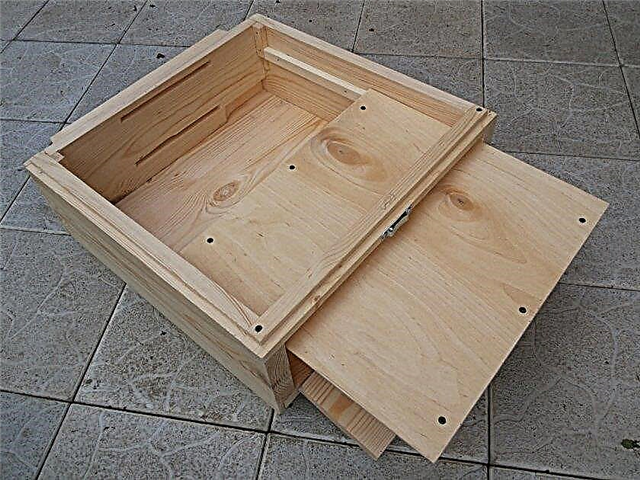
- Extension expands the possibilities of the hive and the bee family. It also provides for folds on the front and rear walls to accommodate half frames. The dimensions of the structure along the length and width should be the same as that of the case, but the height is shortened by half.
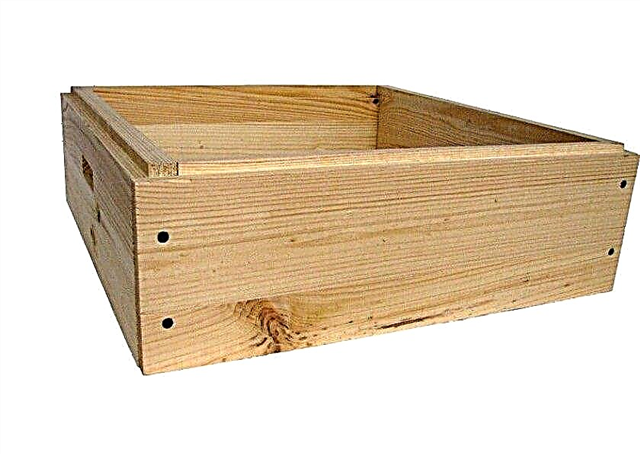
- Awning - the cavity in which the mats are placed for internal insulation. In addition, ceiling boards are fixed on top of the case.

- Ceiling necessary for insulation of the nest. It is assembled from individual boards. Fastens with rails. It can be sheathed with waterproofing materials.

- Roof also comes with separate boards. In the side walls of the roof must be placed holes for ventilation of the structure. The shape of the roof depends on how the hive will be used. It is made flat if hives are installed in the winter for the winter.For regions where hives hibernate on the street, provide a gable or gable roof so that snow or water does not linger on it.

- Insert board limits the size of a bee nest or divides a beehive into 2 halves for two bee families. A set of hives usually make 2 planks. Be sure to provide a rubber seal for them.
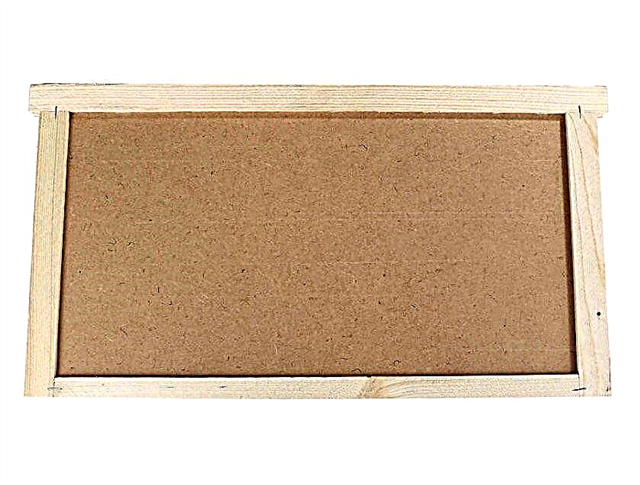
- Nest frame - The main element for the construction activity of bees. In it they will make a honeycomb. The frame is assembled from 4 bars and dividers. You can make the frames yourself. But this is quite complicated, so beekeepers prefer to buy them in a store.

- Half Frames perform the same function, but will be used in the extension. They are used by bees to place nectar during the honey collection period.

- Section frames can be placed in the extension frames. They are necessary for honey bees. They can be store wooden or plastic. The size of the frame is 11 × 11 cm. The place for their placement is the extension frames. To build a honeycomb in each section you will need to insert a wax.

Assembly Instructions:
- Assembly of the unit starts from the bottom after all the parts are completed.
- If the bottom is fixed, then it is attached to the walls of the body with glue or nails. The front of the bottom should protrude slightly behind the hull (arrival board).
- In order for the walls of the structure to hold tightly, they are connected to a tongue. If necessary, then fix with glue. You can also use nails or screws. The walls of the hive must be installed vertically and have an angular connection of 90 °.
- Frames and dividing board are installed. In the hive lounger they are mounted vertically.
- A ceiling is installed from the boards.
- At the end of the assembly, the walls are strapped and the ventilation holes are covered with a mesh to protect other insects from entering the hive.
- Hive staining. This step is not necessary, but if you decide to paint the box in a light shade, then street paint will help to reflect the light and keep cool in the hive during the summer heat. Just do not paint inside surfaces.
Did you know? Bees have existed on Earth for over 30 million years.
When making the design, keep in mind that sun loungers are not portable hives. They are designed for stationary apiary.
Video: do-it-yourself hive sunbed with a bottom from a tick
How to keep bees in a sunbed
Keeping bees requires a small amount of your time - no more than half an hour per week per 1 hive. You can check the hives on a day off or returning from work. In general, you will need to give them no more than 20 hours of your time per year. The hive-lounger is especially good for the formation of layering. This helps the beekeeper to expand the apiary by increasing the number of working bees, and therefore the volume of honey collected.
Important! A new frame is always set until the brood is on the last frame. Otherwise, the bees will enter a swarming state.
Features of keeping bees in a hive-lounger of any size:
- After wintering, be sure to check the condition of the bee family. If you find dead or injured bees and drones, you need to take care of processing from the tick to the start of honey collection.
- At this point, the bees still need to be fed. You must check for its presence in the hive.
- If frost is possible at night, then the hive should be insulated. Warming is removed only with the onset of stable warm weather.
- In the future, the beekeeper controls the filling of the framework. If the queen is on the penultimate cell, then the nest needs to be expanded with new frames with wax, and the processed ones should be moved.
- If the family is large and strong, then in order to provide the bees with work, it is recommended to establish simultaneously 2 new frames with wax. In this case, one rebuilt honeycomb is removed from the hive. The purpose of this operation is to create a supply of honeycombs, which may be urgently needed with copious honey collection or in order to create layers of the bee family.
- Install a new wax frame next to the brood frame, approximately in the center.
- Before the main medical collection, the frames are rearranged. This is necessary to get a multi-honeyed frame and to stock up good supplies for the winter. At the same time, a brood frame is installed near the letka. On one of them must be a queen. A sealed frame pushed deep into the nest.
- The extension is installed before the main medical collection, if the conditions are favorable. If the bees are in a swarm state, then you do not need to install an extension. Bees do not build up a wax if they have begun swarming. They need to give time to break away.
 Also, care for bees includes breeding bees by layering with an old or young uterus. But given the complexity of such an operation for a novice specialist, use the advice of experienced beekeepers on how to properly breed bees.
Also, care for bees includes breeding bees by layering with an old or young uterus. But given the complexity of such an operation for a novice specialist, use the advice of experienced beekeepers on how to properly breed bees.Beekeeping requires not only the presence of hives and bees, but also some skills in working with them. Therefore, it is always convenient to start with simpler hives and activities. And only after gaining some experience, move on to the next.














